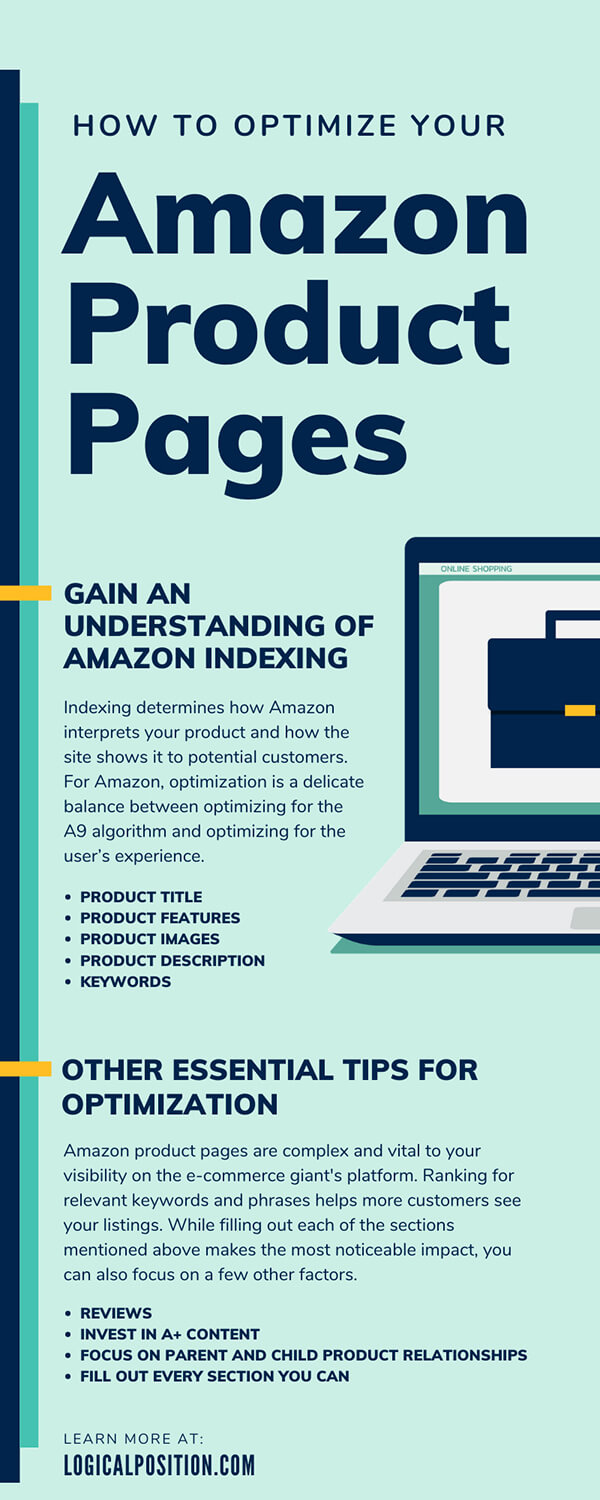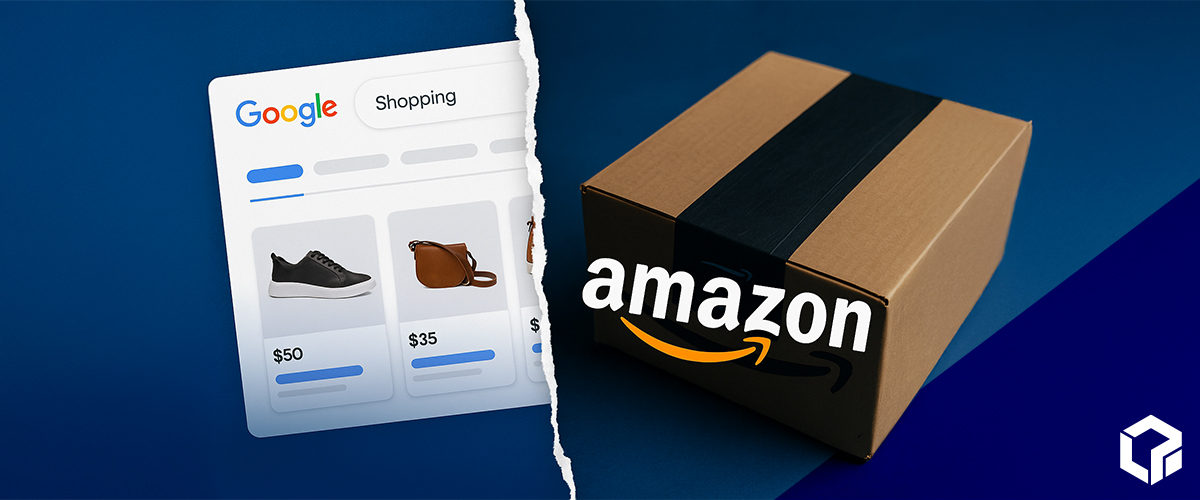Amazon is the leading e-commerce website in the country. It’s a consumer favorite and can lead to amazing sales numbers, but any business will face very stiff competition. E-commerce is already a tough industry to break into—add the competition on Amazon and it can feel nearly impossible to boost sales.
With the right investments in your Amazon storefront and proper product page optimization, you can see results that last. Learning how to optimize your Amazon product pages is the first step to becoming a top seller.
Gain an Understanding of Amazon Indexing
The first step to optimizing your product pages is to gather a basic understanding of how Amazon indexes. Indexing determines how Amazon interprets your product is understood and how the site shows it to potential customers. For Amazon, optimization is a delicate balance between optimizing for the A9 algorithm and optimizing for the user’s experience.
Overuse of keywords in your product title would benefit you via the A9 algorithm, but put you at a disadvantage with the human consumer, as it loses readability. Keyword relevancy is vital—but in realistic doses.
Product Title
When titling your product, ensure you get key phrases in first. Titles are a strong keyword field because they communicate the importance of ranking to Amazon. Title fields allow for many characters, but note that the site may truncate the title at about 80 characters. However, you still benefit from filling out the entire allotted space.
Get your most important, high-value phrases in first and venture into lower-priority keywords later. Make sure you don’t break up the valuable phrases or repeat words too often.
Product Features
The product features included in your product listing influence conversion rates more than product descriptions. People read product features the most out of any element of a product page, as it’s important information in a digestible format.
To properly optimize your product features, include the most critical information and top selling points.
Pro Tip: Sometimes, it can be helpful to mention the things that your product can’t do—especially if there you’ve accrued some negative reviews from customers misunderstanding your product. For example, you can specify that a product is water-resistant rather than waterproof.
For optimal product feature optimization, sneak in phrases and key terms to improve the product’s overall keyword relevancy. Using keywords as much as possible without making the features section seem spammy can help you achieve a variety of phrase matches with high search volume.
Product Images
Amazon allows space for up to nine images per product, including the cover shot or lead image. Pay attention to how you display your product. Show its size, its different angles, its packaging, and how it’s used.
When it comes to product images, consumers generally look for specifications and a true visual on the item—so avoid posting misleading photos or those that don’t accurately represent the actual product the consumer will receive.
Don’t include pictures that are ambiguous about size, function, or use. This can lead to negative reviews if a customer receives something different than what they expected.
Product Description
While not as many people read the product description, it’s still a great place to add numerous keywords and phrases. In the product description, you can tell potential customers more about your product and your business. The description sits further down on the page than the features section, which means many users overlook it—but this doesn’t make it any less useful.
Here are some things to do to best utilize your description section:
Go Into Further Detail
Your feature section bullet points feature limited space and character count. The description is an opportunity to delve into more detail and fully explain all the features of the specific product and your brand. You can even include the benefits of your product that didn’t fit into the feature section.
Back Up Your Features
Customers need proof or convincing to believe in your product’s features—especially if they’re not very familiar with your brand. The description section gives you space to describe how your product works and provide real examples from past purchasers.
Keywords
Keywords are the most important aspect of optimization for Amazon. They are the literal search terms to use in the background or embed into your product listings to communicate what your product should rank for. It’s essential to fill the keyword section with the right terms so your product shows up for the correct phrases.
If a user does a search on amazon that contains a word that is not somewhere in your listing (title, description, product features, or search keywords fields) your product will not be eligible to show as Amazon will not deem it relevant. Therefore it is important to get all of the different keywords you think someone might use to search for your product somewhere in your listing if you want to maximize your eligibility to show on the platform.
Here are a few key things to remember when filling in your product’s keyword section:
- Don’t put commas in between key terms or phrases.
- Look through the search term report.
- Avoid repeating words—Amazon discourages this.
- Start by listing important phrases to get these phrase matches in first.
The character limit is about 250, so try to use it in the most beneficial way you can. You can only get in so many key phrases before repeating terms, so prioritize the most advantageous ones.
Other Essential Tips for Optimization
Amazon product pages are complex and vital to your visibility on the e-commerce giant’s platform. Ranking for relevant keywords and phrases helps more customers see your listings. While filling out each of the sections mentioned above makes the most noticeable impact, you can also focus on a few other factors.
Reviews
Reviews are important. Reviews contribute to your conversion rate because users like to know how other people responded to the product and your brand.
Invest in A+ Content
A+ content can benefit you if you’re eligible to invest in it. This content is available for all brand registered sellers on the platform. If this describes your business, utilizing A+ content will help with conversion rates. It also provides more instances for keywords and gives a more visual and brand-centered way to show more about your product to users.
Focus On Parent and Child Product Relationships
Brands can create a parent product and link all of the child products beneath it. For example, a brand that sells seasonings can list one seasoning and every variation underneath. Another way to link parent and child relationships is to use different amounts. For example, if you sell yarn, you could list a 3-pack of yarn along with the child products: 5-packs and 10-packs. Deciding if you want to use this strategy or use separate listings for each can impact your strategy.
Typically, it depends on the differences between the potential parent and child products. Amazon always recommends linking them when it makes sense. This allows you to cross-sell, upsell, and clean up your product listings.
Pro Tip: If you’re unsure if the parent and child product relationship is right for your brand, you can always test and see which method results in a more favorable performance.
Another thing to keep in mind with parent and child product relationships is that Amazon sometimes groups together the reviews for all of the individual products rather than splitting them up among each.
Fill Out Every Section You Can
Each product type has different listing requirements. Fill out every box or option Amazon provides, including all relative fields for your category. This gives you the most chances to use key terms and phrases to help your products rank and appear in front of users looking to purchase.
Most organic ranking increases on Amazon stem from sales volume and sales velocity. Beyond that, keyword usage to ensure visibility also boosts growth. When optimizing your Amazon optimization product pages, consider working with a digital marketing agency with the proper experience.

Logical Position offers Amazon advertising management services and many other digital marketing services designed to help our clients reach their goals. Contact us today for a free consultation.




